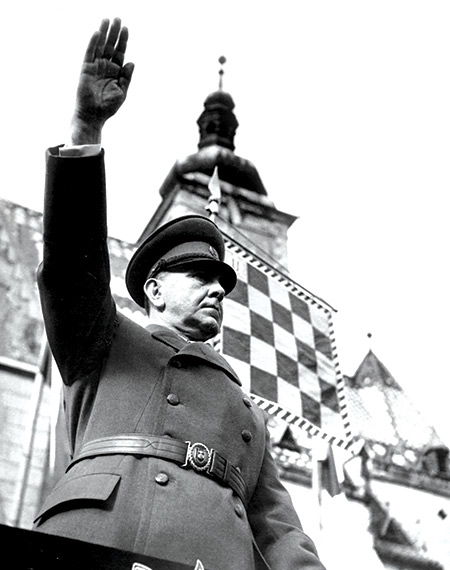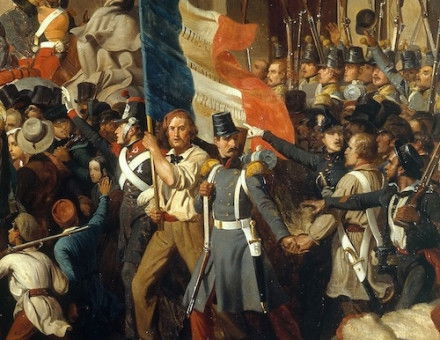Fascism in Croatia
The Independent State of Croatia was founded on 10 April 1941.

Croatian history is complicated. The Croats were Slavs from the area of modern Poland who settled in the Balkans, in the Byzantine Empire, at some date in the sixth century or later. They were converted to Christianity, but unlike their Eastern Orthodox neighbours, the Serbs, the Croats were Roman Catholics. There was a Croatian kingdom in the 10th century, which was later dominated by Hungary. In the 16th and 17th centuries much of Croatia was part of the Ottoman Empire, which was Muslim, and areas of Croatia were later part of the Austro-Hungarian Empire.
After the First World War, the Treaty of Versailles set up an independent state which included Serbs, Croats and Slovenes. It was dominated by the Serbs, who in 1929 named it Yugoslavia. By this time Croatian nationalism had become a significant force and a Croat called Ante Pavelic moved to Fascist Italy, where he founded a nationalist organisation called the Ustasha-Croatian Revolutionary Movement. He had the backing of Mussolini and he won support from Croat exiles in Italy as well as in Croatia itself.
With the Second World War at full tilt, in 1941 the Axis alliance of Germany and Italy invaded Yugoslavia on April 6th. That gave the nationalists the opportunity they had long hoped for and four days later an Ustasha leader called Slavko Kvaternik, a former general in the Yugoslav army, seized control of Zagreb, the Croatian capital, and went on the radio to announce the creation of the Independent State of Croatia. He paved the way for Ante Pavelic to return to Zagreb from Italy with hundreds of other supporters and on April 16th Pavelic declared himself the leader of the new Croatian regime as Poglavnik, or dictator. He appointed Kvaternik as his deputy and other Ustase figures as ministers.
This was gladly accepted by the Axis powers, which treated Croatia as a puppet state. The new Croatia included today’s Bosnia and Herzegovina and also parts of Serbia. The Ustasha rejected the idea that Croats were Slavs and maintained that they were descended from Germanic Goths and were consequently Aryans. They were aggressively Roman Catholic, but they accepted Islam as the other historic faith of Croatian national identity. Sharing Nazi Germany’s ideals and predilections, they wanted a Croatia that was racially pure and they embarked on an extermination programme that in four years would claim hundreds of thousands of victims.
Pavelic banned the Cyrillic alphabet, in which the rituals of the Serbian Orthodox church were written, and started to persecute Jews. In May he went to Rome to see Pope Pius II in the hope of winning Vatican approval, but failed, though the Vatican did send an ambassdor to Zagreb. One of the Ustasha ministers declared: ‘This country can only be a Croatian country and there is no method we would hesitate to use in order to make it truly Croatian and cleanse it of Serbs, who have for centuries endangered us and will endanger us again if given the opportunity.’ In June Pavelic went to Germany to see Hitler, who recommended expelling all Jews from Croatia. In the following month work started on Croatia’s first concentration camps, on the German model.
Pavelic sent some Jews to Auschwitz, but more were sent to the Croatian camps, along with Serbs, gypsies and Croatian and Bosnian opponents of the regime. The most notorious camp was Jasenovac, which opened in 1941 in an area occupied by the German army. The vast majority sent there were Serbs. Some prisoners were lucky enough to be shot dead or killed quickly with a knife, but others died agonisingly in boiling tubs of water, were battered to death with a club or had their heads cut off with a blunt saw.
The German defeat in 1945 put an end to the Ustasha regime. Communist partisans entered Zagreb in May, completing their reconquest of Yugoslavia, and some of the Ustasha leaders were captured. Among them was Slavko Kvaternik, who was executed in Zagreb in 1947. Other Ustasha members hid as inconspicuously as they could in Croatia while some fled to Latin America or even Canada and Australia. Pavelic himself managed to hide in Austria and then in Rome before escaping to Argentina. He was shot and mortally wounded by a Montenegrin near Buenos Aires in 1957.
Long before that, Croatia had been incorporated into the communist republic of Yugoslavia, led by Marshal Tito as prime minister and later president until his death in 1980. The Croats continued to demand greater autonomy and a new independent government announced Croatia’s independence once again in 1991.




